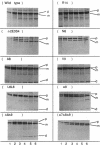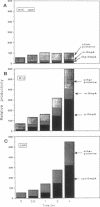Abstract
In previous investigations, we have examined the effect of OmpA signal peptide mutations on the secretion of the two heterologous proteins TEM beta-lactamase and nuclease A. During these studies, we observed that a given signal peptide mutation could affect differentially the processing of precursor OmpA-nuclease or precursor OmpA-lactamase. This observation led us to further investigate the influence of the mature region of a precursor protein on protein export. Preexisting OmpA signal peptide mutations of known secretion phenotype when directing heterologous protein export (nuclease A or beta-lactamase) were fused to the homologous mature OmpA protein. Four signal peptide mutations that have previously been shown to prevent export of nuclease A and beta-lactamase were found to support OmpA protein export, albeit at reduced rates. This remarkable retention of export activity by severely defective precursor OmpA signal peptide mutants may be due to the ability of mature OmpA to interact with the cytoplasmic membrane. In addition, these same signal peptide mutations can affect the level of OmpA synthesis as well as its proper assembly in the outer membrane of Escherichia coli. Two signal peptide mutations dramatically stimulate the rate of precursor OmpA synthesis three- to fivefold above the level observed when a wild-type signal peptide is directing export. The complete removal of the OmpA signal peptide does not result in increased OmpA synthesis. This finding suggests that the signal peptide mutations function positively to stimulate OmpA synthesis, rather than bypass a down-regulatory mechanism effected by a wild-type signal peptide. Overproduction of wild-type precursor OmpA or precursors containing signal peptide mutations which lead to relatively minor kinetic processing defects results in accumulation of an improperly assembled OmpA species (imp-OmpA). In contrast, signal peptide mutations which cause relatively severe processing defects accumulate no or only small quantities of imp-OmpA. All mutations result in equivalent levels of properly assembled OmpA. Thus, a strong correlation between imp-OmpA accumulation and cell toxicity was observed. A mutation in the mature region of OmpA which prevents the proper outer membrane assembly of OmpA was suppressed when export was directed by a severely defective signal peptide. These findings suggest that signal peptide mutations indirectly influence OmpA assembly in the outer membrane by altering both the level and rate of OmpA secretion across the cytoplasmic membrane.
Full text
PDF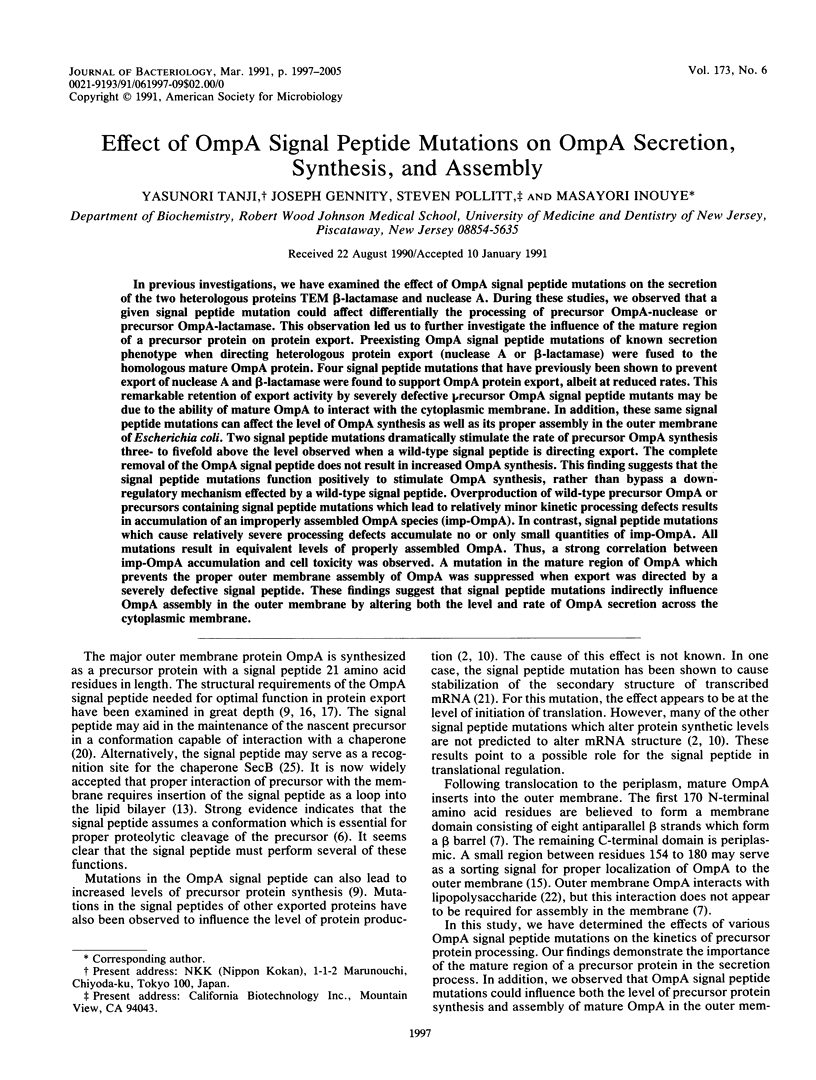
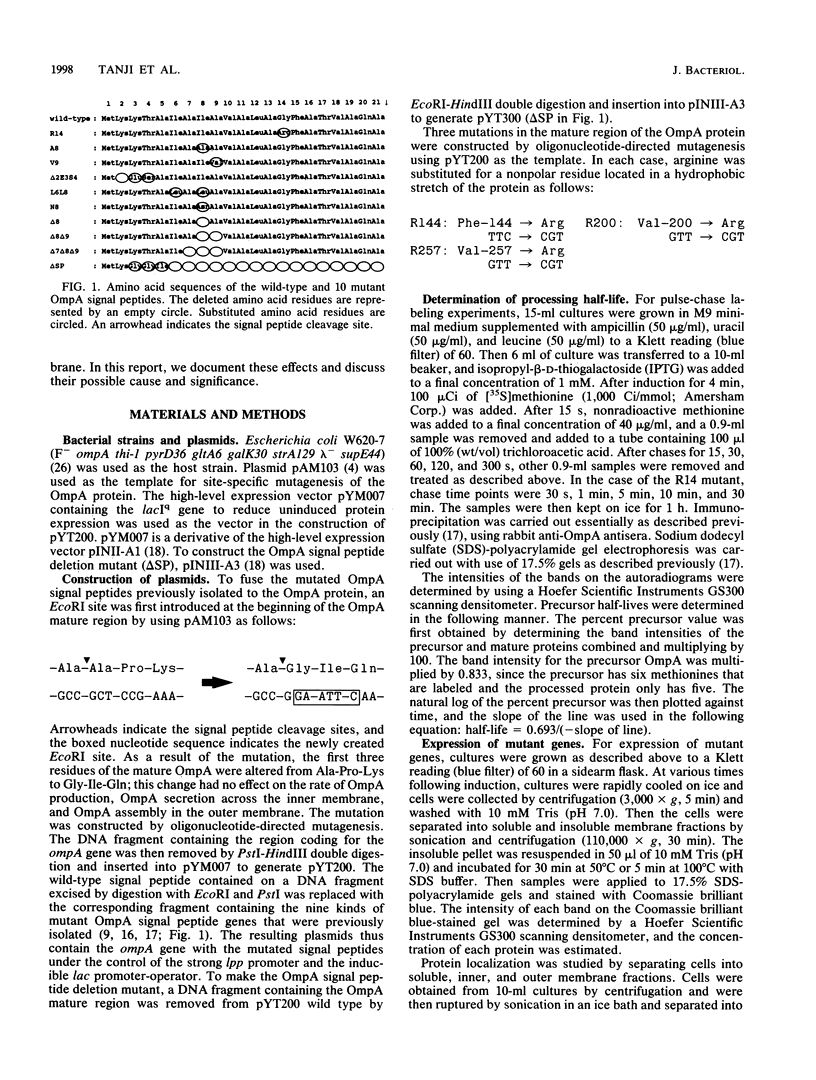

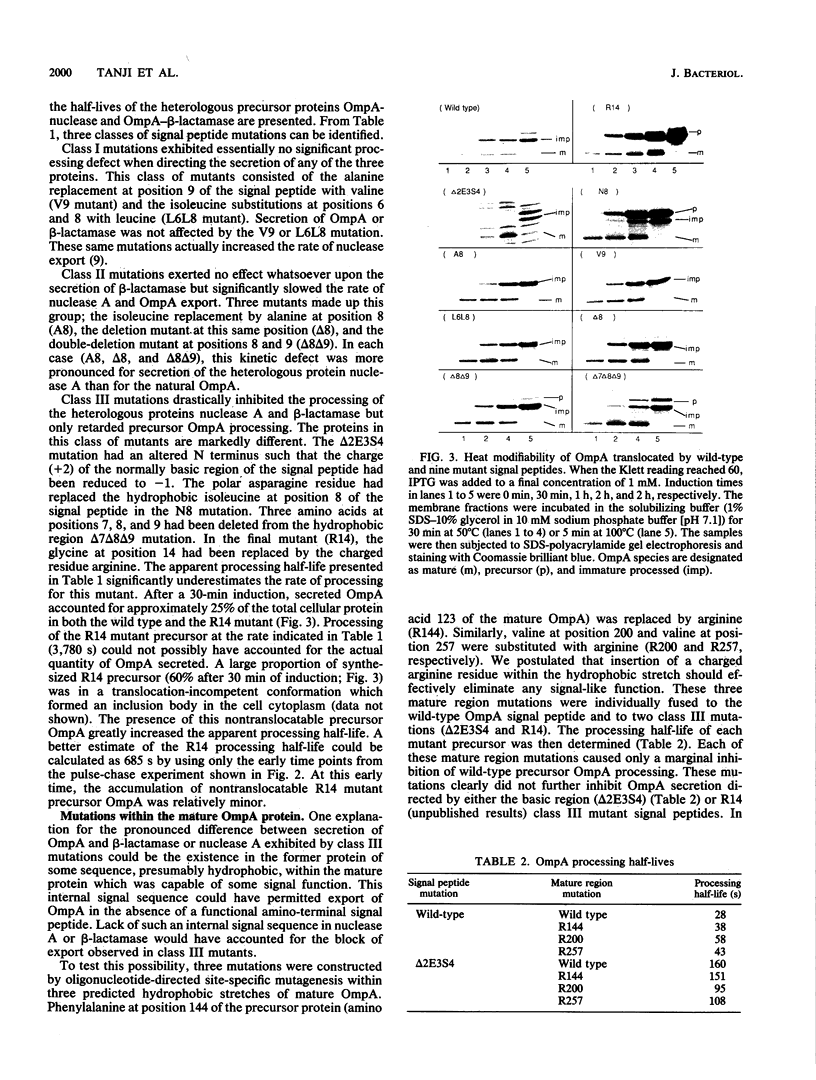


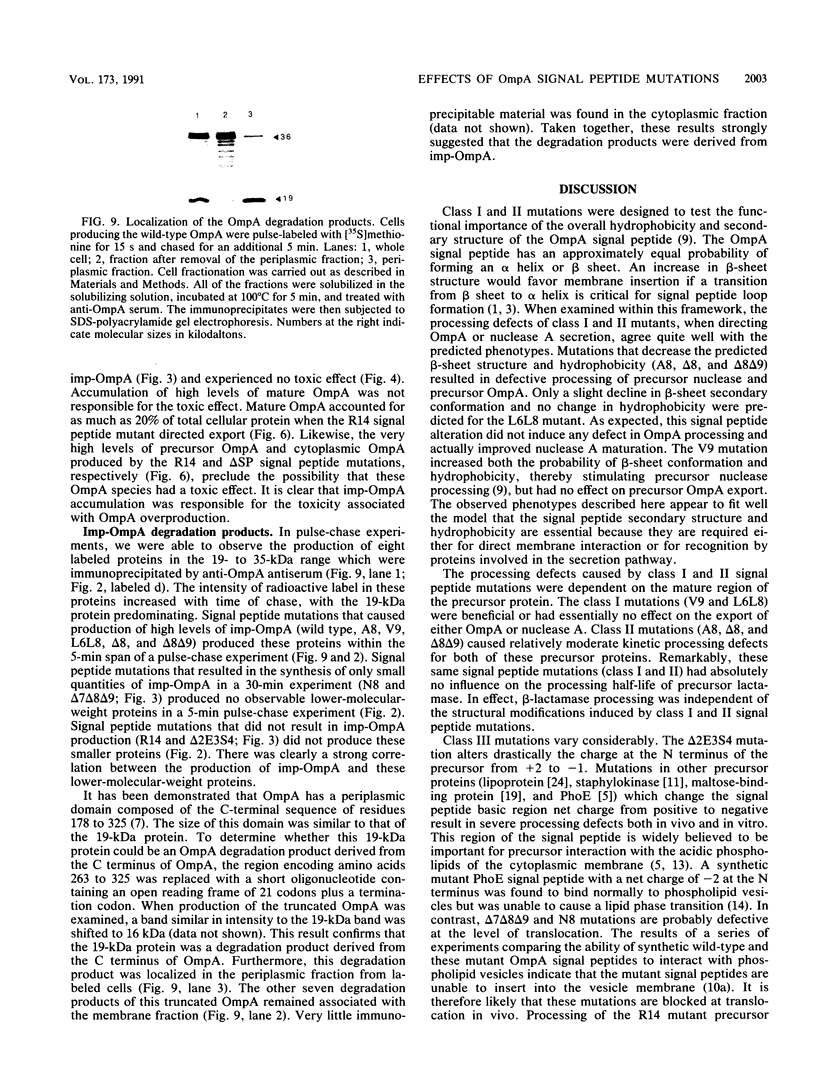
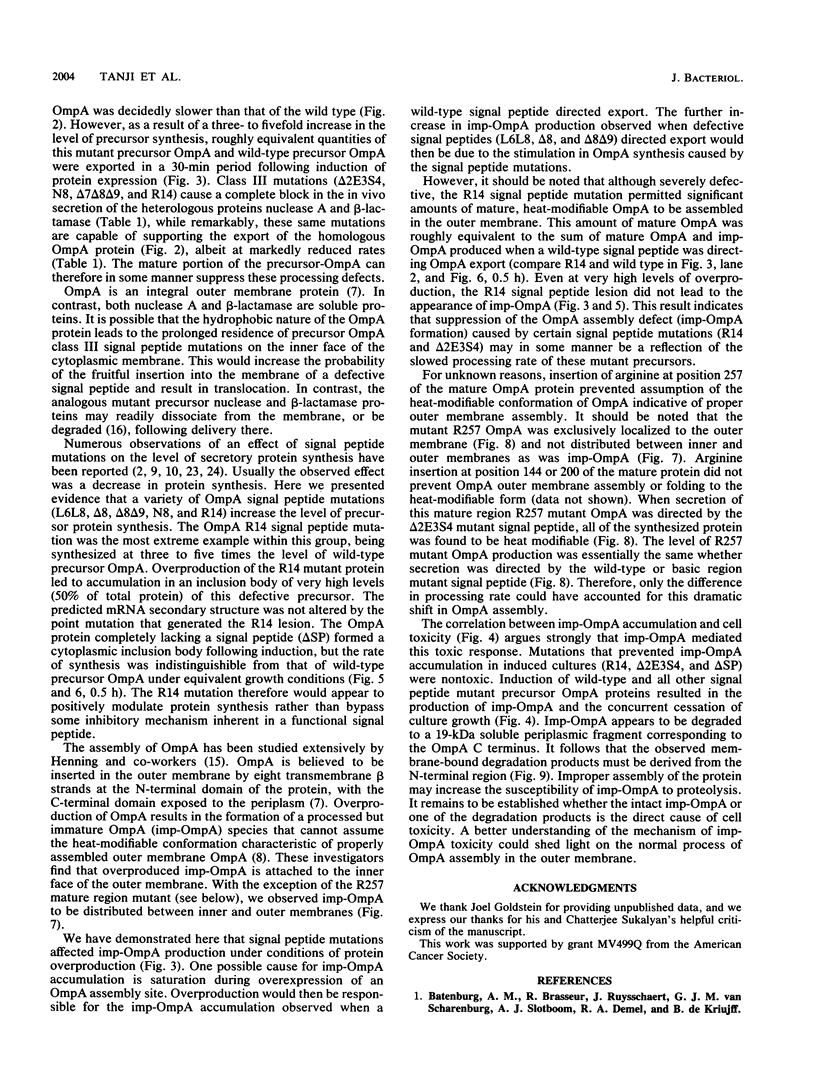
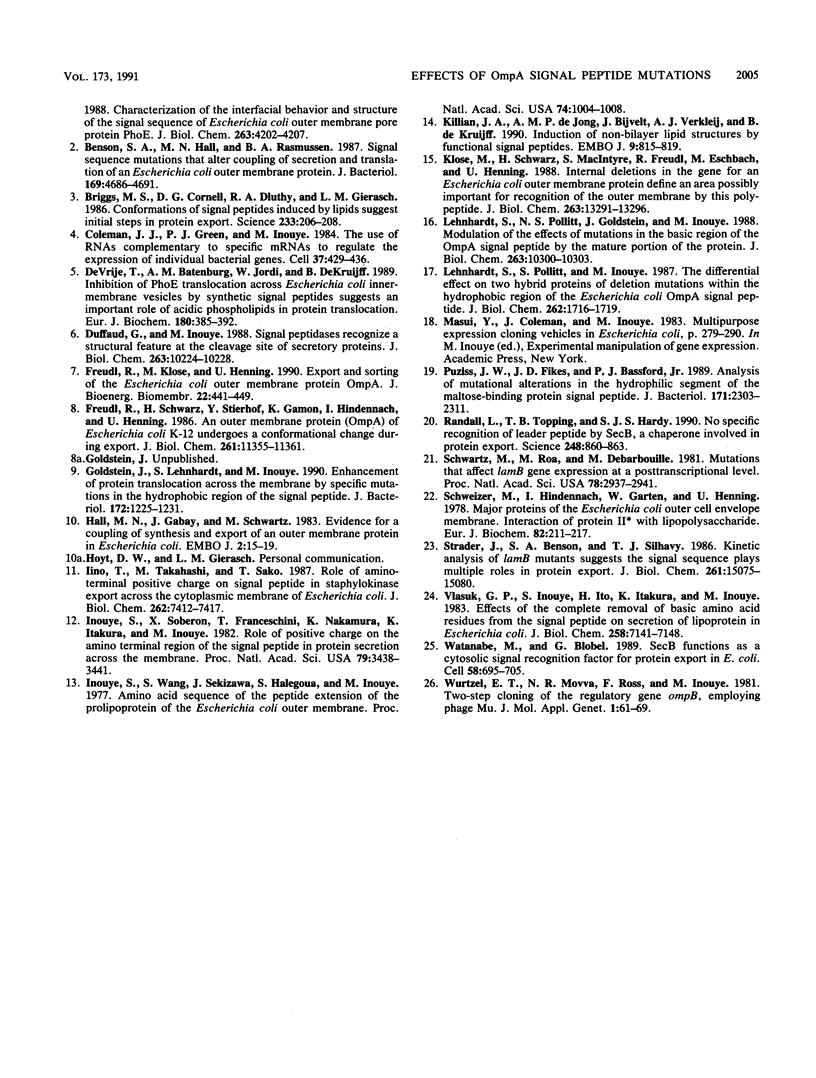
Images in this article
Selected References
These references are in PubMed. This may not be the complete list of references from this article.
- Benson S. A., Hall M. N., Rasmussen B. A. Signal sequence mutations that alter coupling of secretion and translation of an Escherichia coli outer membrane protein. J Bacteriol. 1987 Oct;169(10):4686–4691. doi: 10.1128/jb.169.10.4686-4691.1987. [DOI] [PMC free article] [PubMed] [Google Scholar]
- Briggs M. S., Cornell D. G., Dluhy R. A., Gierasch L. M. Conformations of signal peptides induced by lipids suggest initial steps in protein export. Science. 1986 Jul 11;233(4760):206–208. doi: 10.1126/science.2941862. [DOI] [PubMed] [Google Scholar]
- Coleman J., Green P. J., Inouye M. The use of RNAs complementary to specific mRNAs to regulate the expression of individual bacterial genes. Cell. 1984 Jun;37(2):429–436. doi: 10.1016/0092-8674(84)90373-8. [DOI] [PubMed] [Google Scholar]
- De Vrije T., Batenburg A. M., Jordi W., De Kruijff B. Inhibition of PhoE translocation across Escherichia coli inner-membrane vesicles by synthetic signal peptides suggests an important role of acidic phospholipids in protein translocation. Eur J Biochem. 1989 Mar 15;180(2):385–392. doi: 10.1111/j.1432-1033.1989.tb14660.x. [DOI] [PubMed] [Google Scholar]
- Duffaud G., Inouye M. Signal peptidases recognize a structural feature at the cleavage site of secretory proteins. J Biol Chem. 1988 Jul 25;263(21):10224–10228. [PubMed] [Google Scholar]
- Freudl R., Klose M., Henning U. Export and sorting of the Escherichia coli outer membrane protein OmpA. J Bioenerg Biomembr. 1990 Jun;22(3):441–449. doi: 10.1007/BF00763176. [DOI] [PubMed] [Google Scholar]
- Freudl R., Schwarz H., Stierhof Y. D., Gamon K., Hindennach I., Henning U. An outer membrane protein (OmpA) of Escherichia coli K-12 undergoes a conformational change during export. J Biol Chem. 1986 Aug 25;261(24):11355–11361. [PubMed] [Google Scholar]
- Goldstein J., Lehnhardt S., Inouye M. Enhancement of protein translocation across the membrane by specific mutations in the hydrophobic region of the signal peptide. J Bacteriol. 1990 Mar;172(3):1225–1231. doi: 10.1128/jb.172.3.1225-1231.1990. [DOI] [PMC free article] [PubMed] [Google Scholar]
- Hall M. N., Gabay J., Schwartz M. Evidence for a coupling of synthesis and export of an outer membrane protein in Escherichia coli. EMBO J. 1983;2(1):15–19. doi: 10.1002/j.1460-2075.1983.tb01373.x. [DOI] [PMC free article] [PubMed] [Google Scholar]
- Iino T., Takahashi M., Sako T. Role of amino-terminal positive charge on signal peptide in staphylokinase export across the cytoplasmic membrane of Escherichia coli. J Biol Chem. 1987 May 25;262(15):7412–7417. [PubMed] [Google Scholar]
- Inouye S., Soberon X., Franceschini T., Nakamura K., Itakura K., Inouye M. Role of positive charge on the amino-terminal region of the signal peptide in protein secretion across the membrane. Proc Natl Acad Sci U S A. 1982 Jun;79(11):3438–3441. doi: 10.1073/pnas.79.11.3438. [DOI] [PMC free article] [PubMed] [Google Scholar]
- Inouye S., Wang S., Sekizawa J., Halegoua S., Inouye M. Amino acid sequence for the peptide extension on the prolipoprotein of the Escherichia coli outer membrane. Proc Natl Acad Sci U S A. 1977 Mar;74(3):1004–1008. doi: 10.1073/pnas.74.3.1004. [DOI] [PMC free article] [PubMed] [Google Scholar]
- Klose M., Schwarz H., MacIntyre S., Freudl R., Eschbach M. L., Henning U. Internal deletions in the gene for an Escherichia coli outer membrane protein define an area possibly important for recognition of the outer membrane by this polypeptide. J Biol Chem. 1988 Sep 15;263(26):13291–13296. [PubMed] [Google Scholar]
- Lehnhardt S., Pollitt N. S., Goldstein J., Inouye M. Modulation of the effects of mutations in the basic region of the OmpA signal peptide by the mature portion of the protein. J Biol Chem. 1988 Jul 25;263(21):10300–10303. [PubMed] [Google Scholar]
- Lehnhardt S., Pollitt S., Inouye M. The differential effect on two hybrid proteins of deletion mutations within the hydrophobic region of the Escherichia coli OmpA signal peptide. J Biol Chem. 1987 Feb 5;262(4):1716–1719. [PubMed] [Google Scholar]
- Puziss J. W., Fikes J. D., Bassford P. J., Jr Analysis of mutational alterations in the hydrophilic segment of the maltose-binding protein signal peptide. J Bacteriol. 1989 May;171(5):2303–2311. doi: 10.1128/jb.171.5.2303-2311.1989. [DOI] [PMC free article] [PubMed] [Google Scholar]
- Randall L. L., Topping T. B., Hardy S. J. No specific recognition of leader peptide by SecB, a chaperone involved in protein export. Science. 1990 May 18;248(4957):860–863. doi: 10.1126/science.2188362. [DOI] [PubMed] [Google Scholar]
- Schwartz M., Roa M., Débarbouillé M. Mutations that affect lamB gene expression at a posttranscriptional level. Proc Natl Acad Sci U S A. 1981 May;78(5):2937–2941. doi: 10.1073/pnas.78.5.2937. [DOI] [PMC free article] [PubMed] [Google Scholar]
- Schweizer M., Hindennach I., Garten W., Henning U. Major proteins of the Escherichia coli outer cell envelope membrane. Interaction of protein II with lipopolysaccharide. Eur J Biochem. 1978 Jan 2;82(1):211–217. doi: 10.1111/j.1432-1033.1978.tb12013.x. [DOI] [PubMed] [Google Scholar]
- Stader J., Benson S. A., Silhavy T. J. Kinetic analysis of lamB mutants suggests the signal sequence plays multiple roles in protein export. J Biol Chem. 1986 Nov 15;261(32):15075–15080. [PubMed] [Google Scholar]
- Vlasuk G. P., Inouye S., Ito H., Itakura K., Inouye M. Effects of the complete removal of basic amino acid residues from the signal peptide on secretion of lipoprotein in Escherichia coli. J Biol Chem. 1983 Jun 10;258(11):7141–7148. [PubMed] [Google Scholar]
- Watanabe M., Blobel G. SecB functions as a cytosolic signal recognition factor for protein export in E. coli. Cell. 1989 Aug 25;58(4):695–705. doi: 10.1016/0092-8674(89)90104-9. [DOI] [PubMed] [Google Scholar]
- Wurtzel E. T., Movva N. R., Ross F. L., Inouye M. Two-step cloning of the Escherichia coli regulatory gene ompB, employing phage Mu. J Mol Appl Genet. 1981;1(1):61–69. [PubMed] [Google Scholar]



